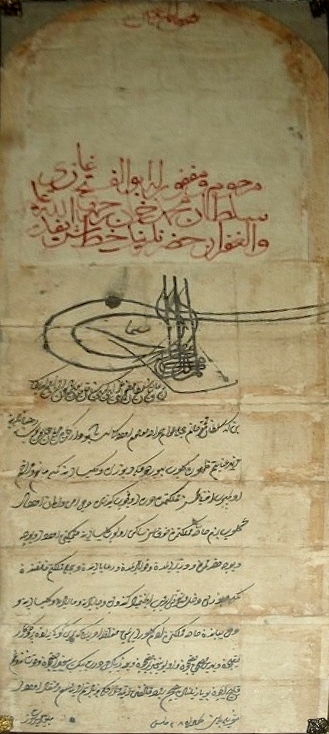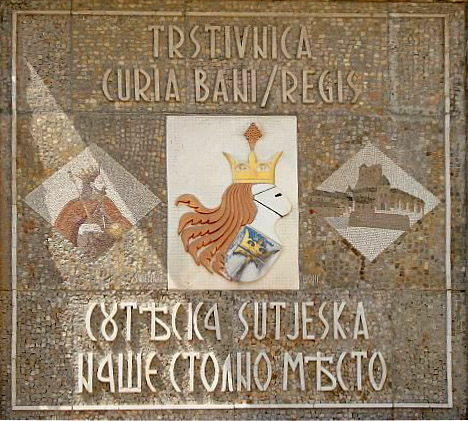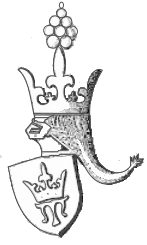|
Milodraž
Milodraž was a settlement in the Kingdom of Bosnia, situated on an important road connecting the towns of Visoko during the Middle Ages, Visoko and Fojnica. No remains of it have been found, but royal charters and Republic of Ragusa, Ragusan documents confirm that one of the residences of King Tvrtko II and King Thomas was located there. Milodraž was first mentioned in a charter Tvrtko II issued to the Ragusans on 18 August 1421, in which he confirmed the grants of his predecessors. The settlement's significance was augmented by two royal weddings which took place in it: the wedding of Tvrtko II and Dorothy Garai, in July 1428, and the wedding of Thomas and Katarina Kosača, in May 1446. It is, however, most notable as the place where Mehmed the Conqueror, following the Ottoman conquest of Bosnia in late May 1463, issued the Ahdname of Milodraž, Ahdname to the Bosna Argentina Franciscan leader, friar Anđeo Zvizdović, promising religious tolerance. Pobrđe Milodraž, the p ... [...More Info...] [...Related Items...] OR: [Wikipedia] [Google] [Baidu] |
Ahdname Of Milodraž
The Ahdname of Milodraž (/Милодрашка ахднама), also called the Ahdname of Fojnica (Фојничка ахднама/''Fojnička ahdnama''), was the ''ahdname'' issued on 28 May 1463 (or 1464) by the Ottoman sultan Mehmed the Conqueror to Bosnian Franciscans, represented by Anđeo Zvizdović. Tradition and history According to Bosnian Franciscan tradition, Mehmed was preparing to depart following the Ottoman conquest of Bosnia when Anđeo Zvizdović came to meet him in the Ottoman military camp in Milodraž. Led in by Mehmed's soldiers, Zvizdović drew the Sultan's attention to the exodus of Catholics from the newly conquered country. The friar specifically pointed to the necessity of maintaining the merchants, craftsmen and miners, and so succeeded in receiving Mehmed's solemn promise of religious tolerance. The Franciscans of Bosna Argentina recognized Mehmed as their sovereign, and in return he promised that "the Bosnian priests shall have freedom and protection ... [...More Info...] [...Related Items...] OR: [Wikipedia] [Google] [Baidu] |
Visoko During The Middle Ages
The area of today's Visoko is considered to be a nucleus from where Bosnia and Herzegovina, Bosnian statehood was developed in 10th century. The expanded valley of the Bosna (river), river Bosna around today's Visoko was the biggest agriculture area in central Bosnia, so fertile ground around Visoko was ideal for development of early political center of Bosnian nobility. The settlement that was in Visoko field has been associated with the name ''Bosna'' (Bosnia) for a long time, only since the 1350s has the name Visoki became widely used. Visoko and its valley with Mile (Visoko), Mile, Moštre and Podvisoki was an early center of the Bosnian medieval state, and the site where some members of the Kotromanić dynasty were buried and the first List of rulers of Bosnia, Bosnian King Tvrtko I was crowned. The old town of Visoki, located on Visočica hill, was a politically important fortress, and its inner bailey, Podvisoki, was an early example of a Bosnian medieval urban area.Pavao An ... [...More Info...] [...Related Items...] OR: [Wikipedia] [Google] [Baidu] |
Pobrđe Milodraž
Pobrđe Milodraž is a village in the municipality of Kiseljak, Bosnia and Herzegovina. Demographics According to the 2013 census, its population was 148, all Bosniaks. See also *Milodraž Milodraž was a settlement in the Kingdom of Bosnia, situated on an important road connecting the towns of Visoko during the Middle Ages, Visoko and Fojnica. No remains of it have been found, but royal charters and Republic of Ragusa, Ragusan doc ..., medieval settlement References Populated places in Kiseljak {{CentralBosniaCanton-geo-stub ... [...More Info...] [...Related Items...] OR: [Wikipedia] [Google] [Baidu] |
Anđeo Zvizdović
Anđeo Zvizdović (or Zvijezdović; 1420 – 7 June 1498) was a Bosnian Croat Franciscan friar and evangelist who is considered by his countermen to be one of the most prominent Bosnians in the History of Bosnia and Herzegovina, country's history. He met with the Sultan Mehmed II and negotiated the Ahdname of Milodraž – granting protection and the freedom of religion to the people of Bosnia following the Ottoman conquest of Bosnia. Religious life Zvizdović is said to have been born to a noble family in the village of Zvizde near Gornji Vakuf-Uskoplje, Uskoplje (modern Gornji Vakuf), from which his surname is derived. According to other accounts, he was born in Vrhbosna (modern-day Sarajevo). His religious zeal was fueled by the sermons of Saint James of the Marches, who served as Vicar of Bosnia in the 1430s. James admitted him to the Franciscan Order and named him Anđeo (Angel); Zvizdović's original name is unknown. Zvizdović was particularly distinguished by his ... [...More Info...] [...Related Items...] OR: [Wikipedia] [Google] [Baidu] |
Bosna Argentina
Franciscan Province of Bosna Srebrena (also ''Bosna Argentina''; officially ) is a province of the Franciscan order of the Catholic Church in Bosnia and Herzegovina, historically active in Croatia as well. Their headquarters are currently in Sarajevo. Monasteries and locations The Province of Bosna Srebrena includes the monasteries in: * Bosnia and Herzegovina at: ** Sarajevo: ::Sarajevo / Bistrik – samostan sv. Ante, ::Sarajevo / Kovačići – samostan Uzvišenje sv. Križa i svetište Nikole Tavelića, ::Sarajevo / Nedžarići – samostan sv. Pavla; ** Rest of Bosnia and Herzegovina: ::Visoko – Samostan sv. Bonaventure, :: Franciscan monastery in Kraljeva Sutjeska – Samostan i župa sv. Ivana, :: Franciscan monastery in Fojnica – Samostan i župa Svetoga Duha, :: Guča Gora Monastery – Samostan i župa sv. Franje Asiškog, ::Dubrave – samostan sv. Ante i župa Bezgrešnog Začeća, :: Livno / Gorica – samostan sv. Petra i Pavla, ::Franciscan monast ... [...More Info...] [...Related Items...] OR: [Wikipedia] [Google] [Baidu] |
Mile (Visoko)
Mile ( cyrl, Миле) is archaeological medieval site located in the Visoko during the Middle Ages, Visoko basin, in present day Arnautovići village near Visoko, Bosnia and Herzegovina. The site was a medieval crowning and burial church of List of rulers of Bosnia, Bosnian kings during the Bosnian Banate and later Kingdom of Bosnia, Kingdom, between its construction in 1340 and the fall of the Kingdom in 1463. Mile is an inscribed as the National Monument of Bosnia and Herzegovina, in 2003 by KONS. History Mile held a great importance for Bosnian nobility and was one of the places for ''Stanak'', the most common name used to refer to the assembly of nobility in medieval Bosnia. Mile was first mentioned (in written sources: Mile, Sv. Nikola, Visoko, Mileševo) in 1244, as a place of the Church of Saints Cosmas and Damian. In 1340, Stephen II Kotromanić built the first Franciscan friary of Saint Nicholas. From 1367 to 1407 several historical sources mention Republic of Ra ... [...More Info...] [...Related Items...] OR: [Wikipedia] [Google] [Baidu] |
Kiseljak
Kiseljak ( sr-cyrl, Кисељак) is a town and municipality located in Central Bosnia Canton of the Federation of Bosnia and Herzegovina, an entity of Bosnia and Herzegovina. It lies in the valley of the Fojnica River, the Lepenica and the Kreševka River, which are a tributary of the Bosna, and it is on the intersection of roads from Visoko, Fojnica, Kreševo and Rakovica. Settlements Demographics 1971 18,335 total *Croats - 10,389 (56.66%) *Bosniaks - 6,822 (37.20%) *Serbs - 924 (5.03%) *Yugoslavs - 55 (0.29%) *Others - 145 (0.82%) 1991 In 1991 the population of the Kiseljak municipality (164 km2) was 24,426, of which 51.61% were Croats, 40.92% Bosniaks, 3.11% Serbs, 2.48% Yugoslavs and 1.88% others. The town itself had a population of 6,598, of which 60% Croats, 29% Bosniaks, 3% Serbs, 5% Yugoslavs and 4% others. 2013 Census Sports The town is home to the football Football is a family of team sports that involve, to varying degrees, kick (football), ... [...More Info...] [...Related Items...] OR: [Wikipedia] [Google] [Baidu] |
Kingdom Of Bosnia
The Kingdom of Bosnia ( / Краљевина Босна), or Bosnian Kingdom (''Bosansko kraljevstvo'' / Босанско краљевство), was a medieval kingdom that lasted for nearly a century, from 1377 to 1463, and evolved out of the Banate of Bosnia, which itself lasted since at least 1154. King Tvrtko I of Bosnia, Tvrtko I (r. 1353–91) acquired portions of western Serbia and most of the Adriatic coast south of the Neretva River. During the late part of his reign, Bosnia became one of the strongest states in the Balkans, Balkan Peninsula. However, feudal fragmentation remained important in Bosnia and the Bosnian nobility held significant power, exercising it at the Stanak meetings where members deliberated on matters such as Royal elections, election of the new king or queen and coronations, foreign policy, sale or cession of territory, contracting and signing treaties with neighboring countries, and military issues. The Ottoman Empire Ottoman conquest of Bosnia a ... [...More Info...] [...Related Items...] OR: [Wikipedia] [Google] [Baidu] |
Mehmed The Conqueror
Mehmed II (; , ; 30 March 14323 May 1481), commonly known as Mehmed the Conqueror (; ), was twice the sultan of the Ottoman Empire from August 1444 to September 1446 and then later from February 1451 to May 1481. In Mehmed II's first reign, he defeated the crusade led by John Hunyadi after the Hungarian incursions into his country broke the conditions of the truce per the Treaties of Edirne and Szeged. When Mehmed II ascended the throne again in 1451, he strengthened the Ottoman Navy and made preparations to attack Constantinople. At the age of 21, he conquered Constantinople and brought an end to the Byzantine Empire. After the conquest, Mehmed claimed the title caesar of Rome (), based on the fact that Constantinople had been the seat and capital of the surviving Eastern Roman Empire since its consecration in 330 AD by Emperor Constantine I. The claim was soon recognized by the Patriarchate of Constantinople, albeit not by most European monarchs. Mehmed continued hi ... [...More Info...] [...Related Items...] OR: [Wikipedia] [Google] [Baidu] |
Katarina Kosača
Catherine of Bosnia ( sh-Latn-Cyrl, separator=/, Katarina Kosača, Катарина Косача; 1424/1425 – 25 October 1478) was Queen of Bosnia as the wife of King Thomas, the penultimate Bosnian sovereign. She was born into the powerful House of Kosača, staunch supporters of the Bosnian Church. Her marriage in 1446 was arranged to bring peace between the King and her father, Stjepan Vukčić. The queenship of Catherine, who at that point converted to Roman Catholicism, was marked with an energetic construction of churches throughout the country. Following her husband's death in 1461, Catherine's role receded to that of queen dowager at the court of her stepson, King Stephen Tomašević. Two years later, forces of the Ottoman Empire led by Mehmed the Conqueror invaded Bosnia and put an end to the independent kingdom. Catherine's stepson was executed, while Sigismund and Catherine, her son and daughter by Thomas, were captured and taken to Constantinople, where they c ... [...More Info...] [...Related Items...] OR: [Wikipedia] [Google] [Baidu] |
Dorothy Garai
Dorothy Garai (/Доротеја Горјанска, ; died between 19 and 24 September 1438) was a Hungarian noblewoman who became Queen of Bosnia upon her marriage to King Tvrtko II in 1428. She functioned as art patron and exerted significant influence over her husband, especially over his relations with church officials, which earned her considerable notoriety in monastic circles. The marriage was harmonious, but childless and cut short by her death in her twenties. Background Dorothea was born into the House of Garai, an extremely powerful noble family of the Kingdom of Hungary. She was one of the daughters of John Garai, '' ispán'' (count) of the Temes County and '' ban'' (governor) of the Bosnian region of Usora. Nicholas I and Nicholas II Garai, Dorothea's grandfather and uncle respectively, served as palatines of Hungary, the highest-ranking officials in the kingdom. Her mother was Hedwig, daughter of Siemowit IV, Duke of Masovia. Dorothy may have been famili ... [...More Info...] [...Related Items...] OR: [Wikipedia] [Google] [Baidu] |
King Thomas
Stephen Thomas ( sh-Latn-Cyrl, separator=/, Stefan Tomaš, Стефан Томаш, sh-Latn-Cyrl, separator=/, label=none, Stjepan Tomaš, Стјепан Томаш; 1411 – 10 July 1461), a member of the House of Kotromanić, reigned from 1443 until his death as the penultimate king of Bosnia. An illegitimate son of King Ostoja, Thomas succeeded King Tvrtko II, but his accession was not recognized by the leading magnate of the Kingdom of Bosnia, Stjepan Vukčić Kosača. The two engaged in a civil war which ended when the King repudiated his wife, Vojača, and married the insubordinate nobleman's daughter, Catherine. Thomas and his second wife, both raised in the Bosnian Church tradition, converted to Roman Catholicism and sponsored construction of churches and monasteries throughout the kingdom. Throughout his reign, Thomas waged a war with the Serbian Despotate over the lucrative mining town of Srebrenica and its surroundings, in addition to (or in conjunction with) mu ... [...More Info...] [...Related Items...] OR: [Wikipedia] [Google] [Baidu] |






